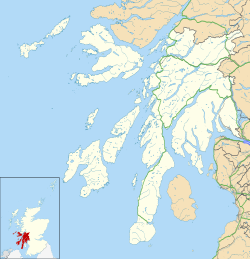Bunessan
| |
|---|---|
 Bunessan village viewed from the road to Fionnphort | |
Location within Argyll and Bute | |
| Population | 107 (1961) |
| OS grid reference | NM381217 |
| Civil parish |
|
| Council area | |
| Lieutenancy area | |
| Country | Scotland |
| Sovereign state | United Kingdom |
| Post town | ISLE OF MULL |
| Postcode district | PA67 |
| Dialling code | 01681 |
| Police | Scotland |
| Fire | Scottish |
| Ambulance | Scottish |
| UK Parliament | |
| Scottish Parliament | |
| Bunessan Lighthouse Eileanan Liathanaitch Gray Islands | |
 | |
| Coordinates | 56°20′34″N6°16′22″W / 56.342770°N 6.272858°W |
| Constructed | 1901 (first) |
| Construction | metal skeletal tower |
| Automated | 2001 |
| Height | 5 metres (16 ft) |
| Shape | quadrangular tower with aluminium panels as daymark |
| Markings | white tower |
| Operator | Northern Lighthouse Board [1] |
| First lit | 2001 (current) |
| Deactivated | 2001 (first) |
| Focal height | 12 metres (39 ft) |
| Range | 8 nmi (15 km; 9.2 mi) (white), 6 nmi (11 km; 6.9 mi) (red) |
| Characteristic | Fl WR 6s. |
Bunessan (Scottish Gaelic : Bun Easain), meaning "bottom of the waterfall", [2] is a small village on the Ross of Mull, a peninsula in the south-west of the Isle of Mull, off the west coast of Scotland. The settlement is at OS grid reference NM382217, [3] within the parish of Kilfinichen and Kilvickeon, [4] and is situated on the A849, [5] at the head of a cove at the southern end of Loch na Làthaich.

